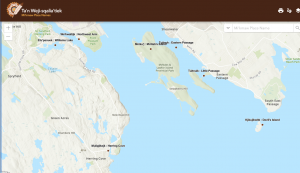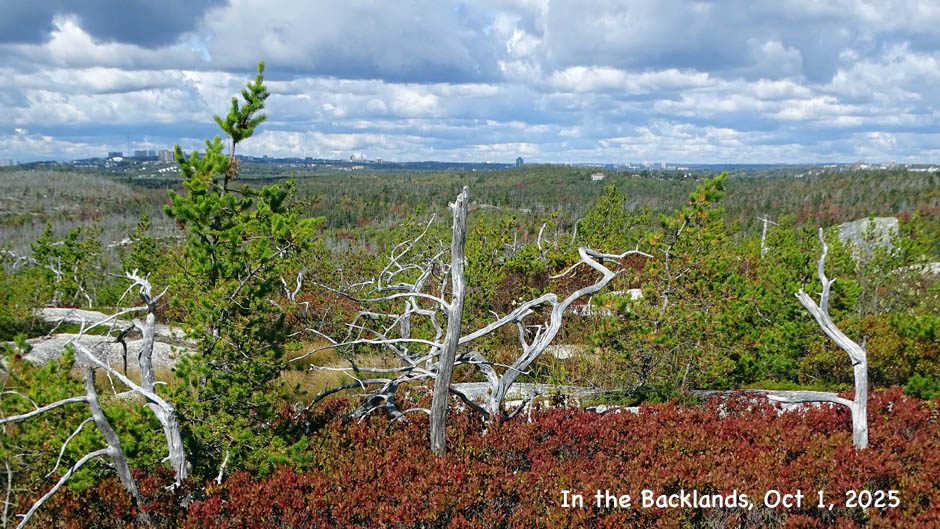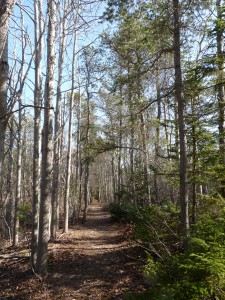
From Ta’n Weji-sqalia’tiek, Mi’kmaw Place Names. In the area of the Backlands, Mi’kmaw names are given for Eti’nauek (Williams Lake) and Mulipjikejk (Herring Cove)
Click on image for larger version
We recognize that these lands are unceded and unsurrendered Mi’kmaw Territory. We are seeking information about traditional use of the Backlands by the Mi’kmaw and would welcome Mi’kmaw guidance and participation in the ongoing stewardship of these lands.
Talking Stick – History of Halifax – A Mi’kmaw Perspective
By Michael McDonald, on www.muiniskw.org “Halifax is known to Mi’kmaq as Chebucto “Kjipuktuk” or “Great Habour”. A number of Mi’kmaq Clans held permanent villages in Kjipuktuk. The Mi’kmaq of Kjipuktuk took advantage of the coves in the harbour since they offered protection from the elements, a place to beach canoes, and a constant supply of fresh water from the streams flowing down from one of many lakes nearby. There was also a wide diversity of marine life in this area that provided food all year round, especially large marine mammals such as grey seals, harbour seals and even Atlantic walruses were plentiful.” McDonald describes the shameful (for Settlers) history that followed the arrival the Europeans and the establishment of “Halifax” on land that was sacred to the Mi’kmaw.
The documents below address the colonial era. Some are about lands abutting onto the Northwest Arm, rather than about the Backlands (as we define them) specifically.
Marcos Zentilli. 2015. Historical importance of the Purcell’s Cove Quarries. Summary Nov. 201, 2015, with photos from NS Archives.
View/Download
Purcell’s Cove Quarries
Photos by David P, Nov 15, 2015 Photos from a HFN field trip in which Marcos Zentilli shares his enthusiasm for the local geology and Purcell’s Cove historic industry sites. View HFN Field Trip Report by Burkhard Plache
Rachael Groat, 2016. Interpretation Planning for Purcell’s Cove Quarries (Rachael Groat). Bachelor of Community Design Honours Thesis (Dalhousie University. “This project explores the geologic history of the Purcell’s Cove quarries through the lens of interpretation planning, with the intent of establishing the cultural and heritage significance of the site.”
View/Download View/Download Summary
View/Download Thesis
Cole Grabinsky, 2016 Interpretation Planning for Purcell’s Cove Quarries (Cole Grabinsky). Bachelor of Community Design Honours Thesis (Dalhousie University).”This project focuses on the industrial history of the Purcell’s Cove granite quarries and follows an interpretation planning process to identify character defining elements. I collaborated with Rachael Groat who explored the geologic history of this area.”
View/Download Summary
View/Download Thesis
Elsie (Purcell) Millington. 2000. Purcell’s Cove. The little place that helped build Halifax City. Self published. ISBN 1-895332-25-7. View description on Doull Books
Heather Watts and Michele Raymond. 2003. Halifax’s Northwest Arm. An illustrated history. Formac Press, Halifax
Heather Watts. 1979. Beyond the NW Arm: A local history of Williams Lake Compiled for the Williams Lake Conservation Co. 1979
View/Download
Nova Scotia College of Art and Design Environmental Planning Studio II. 1995. A Community Study of the Wildlands Area. NSCAD, 36 pages.
“Environmental Planning Studio II set out to prepare background studies to support detailed area planning for the Wildlands [the Backlands]. Our objectives included: 1. to analyze current and historic land uses, including recreational and resource uses of the Wildlands; 2. to determine the attitudes, values and perceptions that community members hold about the Wildlands area.” View/Download
John W. Ragan.1908. Sketches and traditions of the Northwest Arm. McAlpine, Halifax. Available online at Open Library. A facsimile edition was published in 1978 and is available at some used book stores.
Rachael Nicholls. 2015. Exploring Halifax’s Industrial Heritage: The Williams Lake Historic Corridor Honours thesis in School of Planning Dalhousie University, April 10, 2015 View/Download
Janet Kitz and Gary Castle. 1999. Point Pleasant Park. An illustrated history. Pleasant Point Publishing, Halifax. View description on Doull Books
Archival photos A set of 12 photos taken over the period 1870 to 1943, e.g., of iceboating on Williams Lake (1920), the Atlantic sugar house (ca. 1900). View/Download
Connaught Battery and the Defence of the Atlantic Coast, 1906-1941
Roger Sart & Derek Ellis. 2009. Canadian Military History Vol 18(2), Article 6 “Connaught Battery, on the shores of Halifax harbour, has virtually been ignored by historians despite its prominence during a pivotal period in Canadian maritime defence. After taking over the fortifications of Halifax from the British army in 1905-6, when the Imperial armed forces withdrew from the Canadian coasts, the Dominion government built the battery from 1913 to 1916 as part of a larger programme to bring the fortress up to date. The battery’s story bridges the transformation of the fortress from a British bastion against the United States to a Canadian strongpoint that guarded the North Atlantic shipping lanes upon which Britain’s survival depended during the two world wars…..Conclusion: Connaught Battery is well worth preserving. Its design is unique among the coast artillery sites that survive in Canada. It is the only site which features such extensive concrete works within a single structure. It was also the most important permanent fortification undertaken by the Dominion government prior to the late 1930s, representing, like the founding of the Royal Canadian Navy in 1910, Canada’s assumption of the responsibility for the defence of its own shores.”” PDF available at www scholars.wlu.ca
A History of the “Military Road” through the Backlands
As told by Iris Shea, local historian, additions from Terry DeVeau both of Herring Cove, NS, September 2022. Compiled by Martha Leary
Anti-aircraft Battery
Information from Terry Deveau, compiled by Martha Leary, fall 2022
Roy Leitch, Spryfield journalist, and teacher (aka The Hermit of Colpitt Lake
“From his remote cabin in the woods, Mr Leitch produced multiple copies of his typewritten newspaper on a hand-printing press…”



